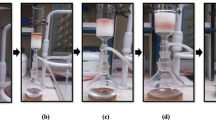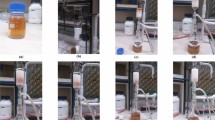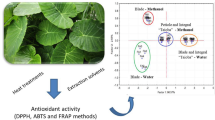Abstract
Propolis is an apicultural product whose composition depends on the climate conditions, geographical region, source of the resinous substance, and bee species. It is rich in phenolic compounds with antioxidant potential. This study aimed to establish better extraction conditions of bioactive compounds from Melipona quadrifasciata (MQ) propolis using a central composite rotational design (CCRD) and multivariate statistical tools. The solvent concentration and extraction time effects on the phenolic compounds profile with antioxidant activity (AA) were evaluated. The total phenolic compounds (TPC) and AA varied from 20.43 to 56.03 mg GAE g−1 (gallic acid equivalent) and 95.89 to 154.67 mmol Trolox g−1, respectively. The best condition for TPC and AA was 50% ethanol and 60 min of the extraction. However, each phenolic compound identified had a different best extraction condition, probably due to the molecules’ polarity and solvent interaction. The cinnamic acid was the highest content identified, followed by ferulic acid, gallic acid, epicatechin, p-coumaric acid, and catechin. Anyway, more extended times of extraction and solvent concentration closer to 50% ethanol can maximise the extraction of compounds with antioxidant potential. Thus, the Brazilian stingless bee propolis could be considered a potential source of bioactive compounds with potent antioxidant capacity, which could be further explored for future applications as natural antioxidants in several products.





Similar content being viewed by others
Data Availability
The data presented in this study are available from the corresponding author upon reasonable request.
References
Alasalvar H, Yildirim Z (2021) Ultrasound-assisted extraction of antioxidant phenolic compounds from Lavandula angustifolia flowers using natural deep eutectic solvents: an experimental design approach. Sustain Chem Pharm 22:100492. https://doi.org/10.1016/j.scp.2021.100492
Almuhayawi MS (2020) Propolis as a novel antibacterial agent. Saudi J Biol Sci 27:3079–3086. https://doi.org/10.1016/j.sjbs.2020.09.016
Bordim J, Marques C, Calegari MA et al (2023) Potential effect of naturally colored antioxidants from Moringa oleifera, propolis, and grape pomace - evaluation of color and shelf life of chicken paté. Food Chem Adv 3. https://doi.org/10.1016/j.focha.2023.100409
Bragança GCM, Ziegler V, Ávila BP et al (2020) Multivariate analysis of the conditions of temperature, moisture and storage time in the technological, chemical, nutritional parameters and phytochemical of green lentils. J Stored Prod Res 87:101617. https://doi.org/10.1016/j.jspr.2020.101617
Cheng J, Sun J, Yao K et al (2022) A variable selection method based on mutual information and variance inflation factor. Spectrochim Acta - Part A Mol Biomol Spectrosc 268:120652. https://doi.org/10.1016/j.saa.2021.120652
Conte FL, Pereira AC, Brites G et al (2022) Exploring the antioxidant, anti-inflammatory and antiallergic potential of Brazilian propolis in monocytes. Phytomedicine Plus 2. https://doi.org/10.1016/j.phyplu.2022.100231
de Barros HEA, Alexandre ACS, Campolina GA et al (2021) Edible seeds clustering based on phenolics and antioxidant activity using multivariate analysis. LWT - Food Sci Technol 152:112372. https://doi.org/10.1016/j.lwt.2021.112372
de Pontes PVA, Czaikoski A, Almeida NA et al (2022) Extraction optimisation, biological activities, and application in O/W emulsion of deep eutectic solvents-based phenolic extracts from olive pomace. Food Res Int 161. https://doi.org/10.1016/j.foodres.2022.111753
Derringer G, Suich R (1980) Simultaneous optimisation of several response variables. J Qual Technol 12:214–219. https://doi.org/10.1080/00224065.1980.11980968
Dewi SR, Stevens LA, Pearson AE et al (2022) Investigating the role of solvent type and microwave selective heating on the extraction of phenolic compounds from cacao (Theobroma cacao L.) pod husk. Food Bioprod Process 134:210–222. https://doi.org/10.1016/j.fbp.2022.05.011
Domínguez-Fernández M, Irigoyen Á, de los Vargas-Alvarez MA MA et al (2021) Influence of culinary process on free and bound (poly)phenolic compounds and antioxidant capacity of artichokes. Int J Gastron Food Sci 25:100389. https://doi.org/10.1016/j.ijgfs.2021.100389
Fadil M, Lebrazi S, Aboulghazi A et al (2022) Multi-response optimisation of extraction yield, total phenols-flavonoids contents, and antioxidant activity of extracts from moroccan Lavandula stoechas leaves: Predictive modeling using simplex-centroid design. Biocatal Agric Biotechnol 43:102430. https://doi.org/10.1016/j.bcab.2022.102430
Farida S, Pratami DK, Sahlan M et al (2022) In-vitro antioxidant, in-vivo anti-inflammatory, and acute toxicity study of Indonesian propolis capsule from Tetragonula sapiens. Saudi J Biol Sci 29:2489–2500. https://doi.org/10.1016/j.sjbs.2021.12.034
Ferreira BL, Gonzaga LV, Vitali L et al (2019) Southern-Brazilian geopropolis: a potential source of polyphenolic compounds and assessment of mineral composition. Food Res Int 126:108683. https://doi.org/10.1016/j.foodres.2019.108683
Fontoura BH, Perin EC, Teixeira SD et al (2023) Multivariate and machine learning approaches for prediction of antioxidant potential in Bertholletia excelsa barks. J King Saud Univ - Sci 35:102792. https://doi.org/10.1016/j.jksus.2023.102792
Gabriel MB, Carneiro MJ, de Camargo RCR, Sawaya ACHF (2022) The chemical composition and antioxidant activity of mandaçaia (Melipona quadrifasciata) geopropolis varies more due to region than month of collection. Nat Prod Res 36:1626–1630. https://doi.org/10.1080/14786419.2021.1892101
Giampieri F, Quiles JL, Cianciosi D et al (2022) Bee products: an emblematic example of underutilised sources of bioactive compounds. J Agric Food Chem 70:6833–6848. https://doi.org/10.1021/acs.jafc.1c05822
Gualberto NC, Nogueira JP, de Souza da Silva A et al (2022) Optimisation of the biotechnological process using Rhodotorula mucilaginosa and acerola (Malpighia emarginata L.) seeds for the production of bioactive compounds. Lwt 160:113190. https://doi.org/10.1016/j.lwt.2022.113190
Guo X, Chen B, Luo L et al (2011) Chemical compositions and antioxidant activities of water extracts of Chinese propolis. J Agric Food Chem 59:12610–12616. https://doi.org/10.1021/jf202818p
Halim MA, Kanan KA, Nahar T et al (2022) Metabolic profiling of phenolics of the extracts from the various parts of blackberry plant (Syzygium cumini L.) and their antioxidant activities. Lwt 167:113813. https://doi.org/10.1016/j.lwt.2022.113813
Harscoat-Schiavo C, Khoualdia B, Savoire R et al (2021) Extraction of phenolics from pomegranate residues: selectivity induced by the methods. J Supercrit Fluids 176:105300. https://doi.org/10.1016/j.supflu.2021.105300
Herrera-Pool E, Ramos-Díaz AL, Lizardi-Jiménez MA et al (2021) Effect of solvent polarity on the ultrasound assisted extraction and antioxidant activity of phenolic compounds from habanero pepper leaves (Capsicum chinense) and its identification by UPLC-PDA-ESI-MS/MS. Ultrason Sonochem 76:105658. https://doi.org/10.1016/j.ultsonch.2021.105658
Hungerford NL, Zhang J, Smith TJ et al (2021) Feeding sugars to stingless bees: identifying the origin of trehalulose-rich honey composition. J Agric Food Chem 69:10292–10300. https://doi.org/10.1021/acs.jafc.1c02859
Janarny G, Ranaweera KKDS, Gunathilake KDPP (2022) Optimisation of ethanol based extraction of phenolics from Ocimum sanctum flowers by response surface methodology. Biocatal Agric Biotechnol 45:102493. https://doi.org/10.1016/j.bcab.2022.102493
Jiang Q, He Z, Wang Y, Wang J (2021) Optimising the working performance of a boat-type tractor using central composite rotatable design and response surface method. Comput Electron Agric 181:105944. https://doi.org/10.1016/j.compag.2020.105944
Kamiya T, Nishihara H, Hara H, Adachi T (2012) Ethanol extract of Brazilian red propolis induces apoptosis in human breast cancer MCF-7 cells through endoplasmic reticulum stress. J Agric Food Chem 60:11065–11070. https://doi.org/10.1021/jf303004n
Kumazawa S, Ueda R, Hamasaka T et al (2007) Antioxidant prenylated flavonoids from propolis collected in Okinawa, Japan. J Agric Food Chem 55:7722–7725. https://doi.org/10.1021/jf071187h
Lavinas FC, Macedo EHBC, Sá GBL et al (2019) Brazilian stingless bee propolis and geopropolis: promising sources of biologically active compounds. Rev Bras Farmacogn 29:389–399. https://doi.org/10.1016/j.bjp.2018.11.007
Liu J, Yang L, Li Y et al (2006) Constructing plasma protein binding model based on a combination of cluster analysis and 4D-fingerprint molecular similarity analyses. Bioorganic Med Chem 14:611–621. https://doi.org/10.1016/j.bmc.2005.08.035
Marzullo L, Ochkur O, Orlandini S et al (2022) Quality by design in optimising the extraction of (poly)phenolic compounds from Vaccinium myrtillus berries. J Chromatogr A 1677 https://doi.org/10.1016/j.chroma.2022.463329
Miyata S, Oda Y, Matsuo C et al (2014) Stimulatory effect of Brazilian propolis on hair growth through proliferation of keratinocytes in mice. J Agric Food Chem 62:11854–11861. https://doi.org/10.1021/jf503184s
Murphy KM, Zerbe P (2020) Specialised diterpenoid metabolism in monocot crops: biosynthesis and chemical diversity. Phytochemistry 172:112289. https://doi.org/10.1016/j.phytochem.2020.112289
Oliveira LPG, Conte FL, de Oliveira CE et al (2019) A new chemotherapeutic approach using doxorubicin simultaneously with geopropolis favoring monocyte functions. Life Sci 217:81–90. https://doi.org/10.1016/j.lfs.2018.11.060
Peng S, Han W, Jia G (2022) Pearson correlation and transfer entropy in the Chinese stock market with time delay. Data Sci Manag 5:117–123. https://doi.org/10.1016/j.dsm.2022.08.001
Peng J, Abdulla R, Li Y et al (2023) Potential anti-diabetic components of Apocynum venetum L. flowers: optimisation, chemical characterisation and quality evaluation. J Food Compos Anal 115:104930. https://doi.org/10.1016/j.jfca.2022.104930
Perin EC, Fontoura BH, Lima VA, Carpes ST (2020) RGB pattern of images allows rapid and efficient prediction of antioxidant potential in Calycophyllum spruceanum barks. Arab J Chem 13:7104–7114. https://doi.org/10.1016/j.arabjc.2020.07.015
Pinela J, Prieto MA, Barros L et al (2018) Cold extraction of phenolic compounds from watercress by high hydrostatic pressure: process modelling and optimisation. Sep Purif Technol 192:501–512. https://doi.org/10.1016/j.seppur.2017.10.007
Rahi S, Mobli H, Jamshidi B et al (2021) Achieving a robust Vis/NIR model for microbial contamination detection of Persian leek by spectral analysis based on genetic, iPLS algorithms and VIP scores. Postharvest Biol Technol 175:111413. https://doi.org/10.1016/j.postharvbio.2020.111413
Rais S, Islam A, Ahmad I et al (2020) Preparation of a new magnetic ion-imprinted polymer and optimisation using Box-Behnken design for selective removal and determination of Cu(II) in food and wastewater samples. Food Chem 127563. https://doi.org/10.1016/j.foodchem.2020.127563
Rocchetti G, Pagnossa JP, Blasi F et al (2020) Phenolic profiling and in vitro bioactivity of Moringa oleifera leaves as affected by different extraction solvents. Food Res Int 127. https://doi.org/10.1016/j.foodres.2019.108712
Saidi F, Khetari S, Yahia IS et al (2022) The use of principal component analysis (PCA) and partial least square (PLS) for designing new hard inverse perovskites materials. Comput Condens Matter 31:e00667. https://doi.org/10.1016/j.cocom.2022.e00667
Santos LA, Rosalen PL, Dias NA et al (2021) Brazilian red propolis shows antifungal and immunomodulatory activities against Paracoccidioides brasiliensis. J Ethnopharmacol 277:114181. https://doi.org/10.1016/j.jep.2021.114181
Santos AC, Carina Biluca F, Brugnerotto P et al (2022) Brazilian stingless bee honey: physicochemical properties and aliphatic organic acids content. Food Res Int 158:111516. https://doi.org/10.1016/j.foodres.2022.111516
Sari R, Conterno P, da Silva LD et al (2020) Extraction of phenolic compounds from tabernaemontana catharinensis leaves and their effect on oxidative stress markers in diabetic rats. Molecules 25. https://doi.org/10.3390/molecules25102391
Singleton VL, Orthofer R, Lamuela-Raventós RM (1999) Analysis of total phenols and other oxidation substrates and antioxidants by means of folin-ciocalteu reagent. Method Enzimol 299:152–178. https://doi.org/10.1016/S0076-6879(99)99017-1
Surek M, Fachi MM, de Fátima CA et al (2021) Chemical composition, cytotoxicity, and antibacterial activity of propolis from Africanized honeybees and three different Meliponini species. J Ethnopharmacol 269:113662. https://doi.org/10.1016/j.jep.2020.113662
Surek M, Cobre A de F, Fachi MM et al (2022) Propolis authentication of stingless bees by mid-infrared spectroscopy and chemometric analysis. Lwt 161. https://doi.org/10.1016/j.lwt.2022.113370
Taşpınar H, Elik A, Kaya S, Altunay N (2021) Optimisation of green and rapid analytical procedure for the extraction of patulin in fruit juice and dried fruit samples by air-assisted natural deep eutectic solvent-based solidified homogeneous liquid phase microextraction using experimental design and. Food Chem 358. https://doi.org/10.1016/j.foodchem.2021.129817
Tomaszewski M, Dein M, Novy A et al (2019) Quantitation and seasonal variation of key odorants in propolis. J Agric Food Chem 67:1495–1503. https://doi.org/10.1021/acs.jafc.8b05965
Wang Y, Chen Y, Zhang X et al (2020) New insights in intestinal oxidative stress damage and the health intervention effects of nutrients: a review. J Funct Foods 75:104248. https://doi.org/10.1016/j.jff.2020.104248
Wang XQ, Wang W, Peng M, Zhang XZ (2021) Free radicals for cancer theranostics. Biomaterials 266:120474. https://doi.org/10.1016/j.biomaterials.2020.120474
Wu Q, Zhang F, Niu M et al (2023) Extraction methods, properties, functions, and interactions with other nutrients of lotus procyanidins: a review. J Agric Food Chem 71:14413–14431. https://doi.org/10.1021/acs.jafc.3c05305
Zhong L, Fang Z, Wahlqvist ML et al (2021) Multi-response surface optimisation of extrusion cooking to increase soluble dietary fibre and polyphenols in lupin seed coat. LWT 140:110767. https://doi.org/10.1016/j.lwt.2020.110767
Acknowledgements
The authors gratefully acknowledge the technical support of the UTFPR–Pato Branco, PR, Brazil, and Analysis Center–UTFPR–Pato Branco, PR, Brazil, and Brazilian National Research Council (CNPq) and Coordination for the Improvement of Higher Education Personnel (CAPES) for the research scholarships.
Funding
This research received funding from the Federal Technological University of Paraná, with postdoctoral and master’s scholarships granted by the National Research Council for Scientific and Technological Development (CNPq) and Brazilian Coordination for the Improvement of Higher Education Personnel (CAPES), respectively.
Author information
Authors and Affiliations
Contributions
Bruno H. Fontoura: investigation, validation, data curation, writing—review and editing; Ellen C. Perin: Data Curation; Anna P. Simon: methodology, conceptualization; Celso F. Bett: conceptualization, validation; Priscila R. Lustosa: conceptualization, validation; Tatiane L.C. Oldoni: investigation, methodology; Vanderlei A. Lima: validation, data curation, editing; José A. Marchese: writing—review and editing; Solange T. Carpes: conceptualization, visualization, supervision, project administration, resources, writing—review and editing. All authors have read and agreed to the published version of the manuscript.
Corresponding author
Ethics declarations
Compliance with Ethics Requirements
This article contains no studies with human or animal subjects.
Competing Interests
The authors declare no competing interests.
Additional information
Publisher's Note
Springer Nature remains neutral with regard to jurisdictional claims in published maps and institutional affiliations.
Supplementary Information
Below is the link to the electronic supplementary material.
Rights and permissions
Springer Nature or its licensor (e.g. a society or other partner) holds exclusive rights to this article under a publishing agreement with the author(s) or other rightsholder(s); author self-archiving of the accepted manuscript version of this article is solely governed by the terms of such publishing agreement and applicable law.
About this article
Cite this article
Fontoura, B.H., Perin, E.C., Simon, A.P. et al. Chemometric Tools to Characterize Phenolic Compounds with Antioxidant Activity of Melipona quadrifasciata Propolis from Brazil. Food Anal. Methods (2024). https://doi.org/10.1007/s12161-024-02611-y
Received:
Accepted:
Published:
DOI: https://doi.org/10.1007/s12161-024-02611-y




